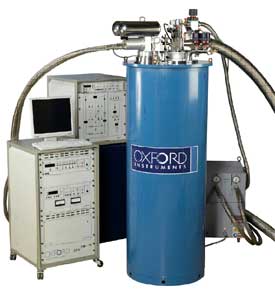Jan 14 2008
As the supply and cost of liquid Helium becomes ever more unstable and expensive, the low temperature physics community faces increasing difficulties in conducting research without spiralling costs. Prof. Amir Yacoby’s group at Harvard University has been trying out a new cryogenic system equipped with Helium re-condensing capability, in order to reduce their liquid Helium usage and so reduce their research costs.
 Cryogenic system with Helium re-condensing capability
Cryogenic system with Helium re-condensing capability
Prof Yacoby commented, “With liquid Helium prices increasing and availability of supply unreliable, managing a low temperature research program is an increasingly difficult task. One of the objectives in setting up my new laboratory at Harvard University has been to expand our activity in cryogenic physics but without a considerable increase in our liquid Helium usage. In using the IntegraTMAC with our Kelvinox®MX and 14T superconducting magnet from Oxford Instruments we expect to have an additional cryogenic system with very little liquid Helium consumption without compromising the measurement capabilities and run time demanded of our research.”
Prof Amir Yacoby is proud to be one of the first to commission this new technology, combining a Kelvinox®MX50 dilution refrigerator and 14T superconducting magnet into the Integra™AC re-condensing cryostat. “The lab results were even better than we had anticipated” says Paul Noonan, Chief Engineer at Oxford Instruments. “The Integra™AC Helium consumption with the dilution refrigerator at base temperature was zero, with some cooling capacity still available within the system. Even with the superconducting magnet running the Helium consumption was close to zero in persistent mode”.
Despite some Helium loss to the gas recovery system from the dilution refrigerator pumps and during sample exchange, the system consumes < 6% of the Helium required to run the equivalent system using a conventional cryostat – an enormous saving in time, running costs and experimental uptime.
Dawn Brooks, Sales and Marketing Director, also commented, “Interest in the Integra™AC from the low temperature community has been tremendous since its unveiling at APS 2007 March Meeting in Denver, particularly in North America where Helium shortages have been most acute. We have been cautious over its performance whilst under development and this result is a terrific achievement for our cryogenic specialists who have designed this unique system. I anticipate many more to be installed in the coming months around the world.”